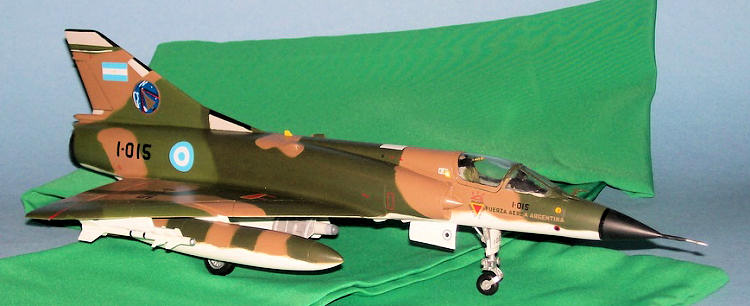
ESCI 1/48 Dassault Mirage IIIEA "I-015
| KIT #: | 4073 |
| PRICE: | $? |
| DECALS: |
Aerocalcas # 48008 |
| REVIEWER: | Pablo Calcaterra |
| NOTES: | The three lives of a kit |

| HISTORY |
The
Argentine Air Force evaluated several options to replace the F86F-40s in service
as its mainstream interceptor. Options included British, Swedish and American
planes but as the Israelis had flown the Mirage
Planes were delivered with Cyrano II radar (French pilots flying in Chad against
Libya around 1980 would later claim that this radar would not even lock on a
cloud) and Matra 530 missiles (infrared and semi active radar: that means that
the target had to be illuminated all time by the fighter to guide the missile).
The only main difference in terms of equipment was that the Argentine planes did
not have a Doppler system and the presence of two little wings on the top of the
tail, close to the rudder.
In
1977 a new contract was signed, this time adding 7 more single seat fighters to
be delivered in 1979 and supplied with Magic I missiles.
During 1978 tensions with
In
1980 Matra 550 missiles were purchased as the 530 was not suitable for short
distance combats.
Two
more trainers (IIIDA) were delivered in 1982 (contract signed in 1980).
Planes from the first and second lots differed in the fact that the late had 2
more stations, wiring for Magic I (or 550) and a little dorsal antenna for the
TACAN system (later added to the first lot as well).
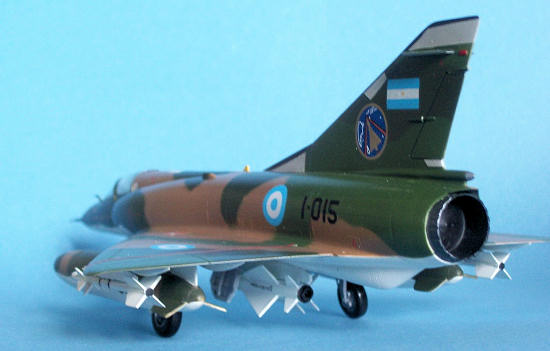 In
1982 the Mirage IIIEA were the only interceptors in service in the Argentine Air
Force. The pilots were very well trained.
In
1982 the Mirage IIIEA were the only interceptors in service in the Argentine Air
Force. The pilots were very well trained.
Three planes (I-011 / 016 / 019) were sent to Patagonia (BAM Rio Gallegos) at
the end of March 1982 in preparation for the actions to retake the Malvinas
(known as Falklands to the English speaking world). They did not take direct
part in the actions of April 2nd.
Two
squadrons were formed: one in Comodoro Rivadavia, under the command of Mj. Hugo
Paez and with 5 planes (I-003 / 008 / 010 / 015 / 018) and another 5 in Rio
Gallegos, led by Mj. Jose Sanchez and with I-0111 / 014/ 016/ 017 and 019).
Later on, I-005 and 006 arrived in Comodoro and thus I-015 and 018 were
transferred to Gallegos. Three planes were left to protect Buenos Aires. April
was spent training, getting used to the new maritime environment and getting the
Magic I operational.
Tactical situation was not favorable for the Mirages, as they had to defend the
continental Argentina against possible attacks from Vulcans, escort
fighter-bombers and prevent attacks from the Sea Harriers and Harriers over the
islands. Too many tasks for such a small group of planes.
The
first Operational Order (OF 1091) that the Air Force issued during the war was
for the Mirages in Rio Gallegos. On May 1st, after the Vulcan attacks
on Puerto Argentino (Stanley) a couple of MIII (Major Sanchez and Captain
Czerwinski) orbited above the town without making contact with the enemy, though
a couple of British PACs from HMS Invincible were in the area.
The
first (inconclusive) engagement happened when 2 MV Daggers (Moreno and Volponi)
faced 2 Sea Harriers (Kent and Haigh)
An
attack by four A4-B led by Captain Hugo Palaver (call sign TOPO) was to be
escorted by a sections of MIII flown by Captain Gustavo Argentino Garcia Cuerva
(nickname Paco, an instructor in the VIII Brigada Aerea) in I-019 and 1st
Lt. Carlos Perona (Dardo) in I-015 (OF 1093 – call sign TABLON). Due to the
confusion created by the Harriers attacks, lack of experience and British
electronic measures, the Skyhawks were sent to intercept a British PAC (801 Sqn
pilots Commander John Eyton-Jones and Flight Lt Paul Barton)…but they were armed
with bombs! Garcia Cuerva and Perona, by then, had reached their turning point
and were returning to the continent (one of the disadvantages of the MIIIEA
during the war, besides the armament, was the lack of endurance). The radar
operator in Argentino realized the serious mistake and asked the Skyhawks to
escape as the Harriers were on their tails 30 miles behind and eating out the
distance. In the meantime, Garcia Cuerva and Perona were following the events on
the radio and the leader asked the radar to lead them to the Harriers.
Therefore, now running low on fuel the MIII turned back to the islands to face
the Harriers and get to their tails. Faced with 4 planes ahead of them and 2
more that were trying to get them, the Harriers left the Skyhawks alone and
turned to face the Mirages. They enemy PACs crossed head on with a difference of
attitude of 4,000 ft and after the crossing they turned to return to their
bases. There was no radio communication during the return trip as the Mirage
pilots were really concerned about their fuel status. Only when the continent
coastline was in sight Garcia Cuerva broke the silence and commented about the
tense moments they had just experienced. After landing, all 6 pilots embraced
each other and celebrated the fact that they had made it back. With this almost
heroic intervention, Garcia Cuerva and Perona saved the lives of the A4 pilots.
All
excited about the last events, they went to the Debrief. There, Captain Carballo,
waiting for his turn to attack, heard them chatting excitedly and overheard,
same as others, Garcia Cuerva saying that if he’d run very low on fuel (to the
point of making the return impossible) he would risk a landing in Puerto
Argentino (Stanley).
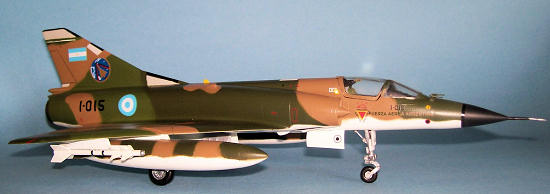 On
this day, the next MIIIEA missions were flown by 1st
Lts. Yebra /
Puig, (OF 1098 FOCO) and Capt. Gambande / 1st Lt Yebra (OF 1108
BUITRE) flying again from Gallegos. The FOCOs were ordered to chase to contacts
that seemed to be returning to their aircraft. It was the British
On
this day, the next MIIIEA missions were flown by 1st
Lts. Yebra /
Puig, (OF 1098 FOCO) and Capt. Gambande / 1st Lt Yebra (OF 1108
BUITRE) flying again from Gallegos. The FOCOs were ordered to chase to contacts
that seemed to be returning to their aircraft. It was the British
At
the same time that the BUITRE were taking off, Garcia Cueva and Perona were also
starting their second mission of the day. Their OF was 1109 and call sign DARDO.
Official Air Force records show that the leader flew again in I-019 and his
wingman in I-015 (but there is new evidence that shows that in fact Garcia
Cuerva was this time in I-015). Their patrol area was to the North of the
islands. A pair of Sea Harriers from 801 Sqn. (Paul Barton and Steve Thomas) was
vectored by HMS Glamorgan. The Argentine controller guided them towards the
British PAC but failed to mention that it was two enemy planes. The Mirages were
flying higher than the Harriers. As happened in the first action, they were
flying head on. In this occasion though Paul Barton was the “Eye ball” (bait)
and Steve Thomas the “Shooter”. That means that Thomas flew in sight of the
Mirages, but Burton separated from his leader unseen by the Argentines. So while
Garcia Cuerva and Perona had their eyes fixed on Thomas, Burton was gaining
their tails undetected. Garcia Cuerva was the first one that saw the Harrier and
said: “In sight! Let’s get them!” He dropped his external fuel tanks (again,
some British books mistake the fuel escaping from the dropping tanks with
missiles) but Perona’s right one refused to drop. His only option was to eject
the Magics, stations and the tank but that would leave him with no effective
armament. He decided to try to fight with his heavy and unbalanced plane.
Barton was flying lower than the Mirages who crossed in front of him. He fired a
burst of his 30 mm Aden guns but missed. The Mirages started to pull away (a
difference of 150 knots!) and therefore Barton decided to fire a Sidewinder to
the wingman. He acquired Perona’s Mirage exhaust clearly, against the cold sky
above. One mile behind the Argentine plane, Barton fired his Sidewinder. Thomas,
Garcia Cuerva and Perona crossed head on at very high speed. The Argentines
decided to start to climb to engage Thomas in a scissors maneuver. Garcia Cuerva
shouted to Perona to break as he had been fired a missile. But it was too late.
The missile exploded and seriously damaged the Mirage. The crossing and the
explosion of the missile happened in such a short period of time, that Perona
initially though that he had collided against the Harrier. Barton though that he
pilot could not have survived the explosion. But in fact he did. And the plane
was still flying. With all alarms ringing and the fire indicator on, he turned
off the engine and glided towards the coast of Borbon (Pebble) island. As Perona
did not have a suit that would allow him to survive in the cold water, he
decided to try to eject over land. Finally he reached the shoreline and ejected.
It was really windy and he had to fight all the way down against the wind that
was pushing him to the water again. Just about the moment that he was going to
land, a wind gust unbalanced him and he broke one foot. He managed to land 20
meters away from the water! One
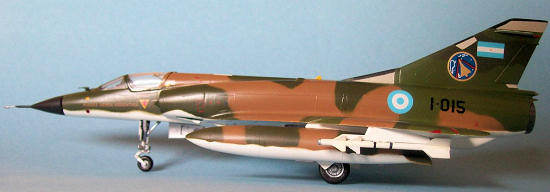 hour after sustaining this hard fall, he was
rescued by an Augusta A109A (Argentine Army – Batallon de Aviacion de Combate
601) and taken to Puerto Calderon / Pebble settlement in Borbon and from there,
in a Beechcraft 200 (Argentine Navy) to Rio Grande in the mainland. Perona’s
plane crashed in a small bay on the south side of Borbon/Pebble.
hour after sustaining this hard fall, he was
rescued by an Augusta A109A (Argentine Army – Batallon de Aviacion de Combate
601) and taken to Puerto Calderon / Pebble settlement in Borbon and from there,
in a Beechcraft 200 (Argentine Navy) to Rio Grande in the mainland. Perona’s
plane crashed in a small bay on the south side of Borbon/Pebble.
In
the meantime, Garcia Cuerva and Thomas had an unsettled matter. With the great
maneuverability of the Harrier, Thomas gained the tail of the Mirage. Garcia
Cuerva decided to dive to the clouds that were at 4,000 ft. Spiraling down he
went, chased by a Sidewinder that Thomas fired at him. The Sidewinder passed
closed to the Mirage’s tail and Thomas lost both missile and plane as they
entered the cloud. I quote for the record ”The missile streaked after him and
just before he reached cloud I saw it PASS CLOSE to his tail. Then both the
aircraft and the missile vanished” (Steve Thomas, Air War in the Falklands 1982
by Christopher Chant, Osprey, 2001). It has been widely claimed that the missile
managed to damage the Mirage and that is why, leaking fuel, the pilot tried to
make an emergency landing. Here you can see that Thomas says that the missile
PASSED close to the tail and he did not see it actually explode.
Garcia Cuerva had less fuel than necessary to return to his base. He decided to
try to land in the small airstrip in Puerto Argentino / Stanley (1,500 mt long).
It was going to a challenging feat but he was an extremely experienced Mirage
pilot. He could pull it out in 700 mts using the breaking parachute. Therefore
Garcia Cuerva asked for permission to land but he was denied it as the base was
under Red Alert due to the fact that it was under attack (3 British ships were
shelling the area from the coast). Three Daggers (Dimeglio, Aguirre Faguet and
Roman) were at the same time approaching the British ships low over the water.
Covering them, 2 more Daggers (Donadille and Senn) were circling above. They
heard the communications back and forth between the Argentine controller and
Garcia Cuerva. When Garcia Cuerva was told to eject from his plane, Donadille
heard him answer: “It’s a pity. The plane is new…pristine”. He kept on insisting
to be allowed to land. Finally permission was granted and coordination with all
the AA systems around the field was verbally made (the 3 Argentine Forces –
Army, Navy and Air Force – had their anti aircraft armament in the area). Senn,
hearing the exchange, almost broke the radio silence to ask Garcia Cuerva to
eject. But his discipline prevailed.
Approaching to land from the West, Garcia Cuerva had to fly over land and some
Argentine positions. To reduce the weight (and thus the inertia) of his plane he
dropped his missiles in the area around the Royal Marines barracks. Upon seeing
this, the inexperienced and nervous Navy gunners mistook the missiles for bombs
and started to shoot at him with their 35 mm guns. Everyone followed suit (AA,
soldiers) and opened fired. From the CIC they shouted on the radio: “Don’t
shoot! He is ours! Don’t shoot!” The 5 Dagger pilots heard the dramatic calls.
Garcia Cuerva’s plane started to smoke and turn out of course to his right,
flying over the town and shedding pieces. Flames started to shoot from the
exhaust of the stricken Mirage. The gunners would not let go. Several civilians
saw this. Paco exclaimed: “They are shooting at me! Damn!” (Me estan tirando a
mi…Carajo!). Most likely injured by the fire, he was unable to eject. His plane
crossed over the town curving from Northwest to Southeast (the airport is
straight North of the town in a small peninsula), his 30 mm guns fired some
bursts (due to damage or triggered by the injured Garcia Cuerva?) and crashed in
shallow waters on the south shore of the bay located to the south of the town.
The plane broke in two main parts upon hitting the water, just behind the
cockpit.
 The
3 Daggers attacked the British ships successfully, these fled the area and the 2
high flying Daggers saved them from some aggressive Harriers that were after
them after the first air to sea combat of the war. They all returned safely and
told the story…but that is another story for another model plane I will make in
the future!
The
3 Daggers attacked the British ships successfully, these fled the area and the 2
high flying Daggers saved them from some aggressive Harriers that were after
them after the first air to sea combat of the war. They all returned safely and
told the story…but that is another story for another model plane I will make in
the future!
This
mission proved the failures of the Mirage
Also, this led to the painting of yellow ID areas on the MIIIEA: rudder and
wingtips in yellow. Soon afterwards, these bands were overpainted in dark brown
as several pictures show.
The
Mirage
OF
1185 Aguila (Capt. Juck / 1st Lt Selles)
OF
1186 Condor (Mj Sanchez / 1st Lt Maggi)
OF
1200 Ciclon (Capt. Czerwinski I-017 / 1st Lt. Puig I-014)
On
the 22nd, two more missions were flown:
OF
1208 Piton (Mj. Sanchez / Capt. Czerwinski)
OF
1209 Cobra (Capt. Huck / Capt. Ballesteros)
During the evening, a plot was detected by the radar in Comodoro Rivadavia. A
Mirage IIIEA was sent to intercept (1st Lt Bosich), armed with an
infra red Matra 530. He made contact with his radar but as there was a Pucara
also flying in the area, he was told to do a visual confirmation. This made him
loss the contact and no combat took place.
Other missions to cover attack planes were flown from the 26th
onwards.
OF
1242 Sombra (Capt. Ballesteros / 1st Lt Puig). They were protecting
the Pocker section. There were 3 British
OF
1252 Nene (Capt. Huck / Capt Gonzalez)
On
the 31st, knowing that a small landing ground had been established by
the Task Force in San Carlos, 2 sections of Mirage were sent to try to lure the
Harriers to take off and thus give out the exact position of this place. It
proved fruitless. These were flown by the same pilots (Capt. Ballesteros / Capt.
Arnau) with 10 hours elapsing between the first and second mission.
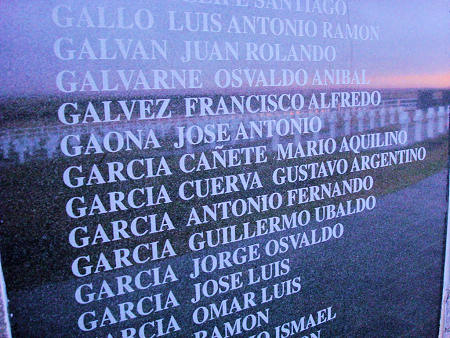 The
next significant mission happened on June 8th. On this date, Lt.
Sanchez was returning alone after Sea Harriers had shot down his other 3 friends
after they had sunk Foxtrot 4. Ward and Thomas were about to chase this last
Skyhawk when HMS Cardiff ordered them to climb to engage an Argentine
The
next significant mission happened on June 8th. On this date, Lt.
Sanchez was returning alone after Sea Harriers had shot down his other 3 friends
after they had sunk Foxtrot 4. Ward and Thomas were about to chase this last
Skyhawk when HMS Cardiff ordered them to climb to engage an Argentine
At that moment, the British dove away and the Argentine controller lost them in
the radar.
On
June 10th the crew of an Argentine Air Force Boeing 707 flying a
long-range recco mission saw 3 enemy planes flying South (one large and two
small) well out over the sea. It was considered that it was a tanker bringing
two more new Harriers to the area. Two
The
last mission of the Mirage IIIEA took place during the last night of combats. A
section of Canberras was sent to bomb the British positions in Mount Kent. HMS
Exeter fired several Sea Darts, one of which shot down the last Argentine plane
of the war (Canberra B-108 with Capitanes Pastran – ejected - and Casado –
killed in the plane when his seat failed to eject). The Mirages were flying
according to OF 1327 (Pluton) and the pilots were Mj Sanchez and Capt Gonzalez.
There were no enemy PACs in the area. HMS Cardiff fired Sea Darts against the
Mirages. Sanchez observed the missiles fired at the Canberras, the flares
dropped by them to attract the missiles, the bombs exploding on the ground…Then
he saw a second group of missiles coming up. One of them was getting closer and
closer, growing in size. He had no doubts: it was coming to his Mirage! He was
flying at 10,000 mt and turning gently. Sanchez then reduced his engine, started
to dive in a spiral, leaving the Sea Dart in the center of his trajectory. Then
suddenly the missile exploded in a shower of white and orange sparkles.
Relieved, he sighed. But not for too long. Another Sea Dart was climbing and
passed him on his right. The missile kept on climbing so he was now safe.
Looking back to his instruments, he realized that he was flying at only 5,000 mt
and the radar in Puerto Argentino told the Mirage pilots that they were too
close to Darwin. The fighters climbed to safety and could hear the surviving
Canberra calling in vain the other bomber. The three planes landed together in
Rio Gallegos on the third minute of June 14th, 1982. The last
missions of the Argentine Air Force during the war had ended as the Argentine
garrison signed the cease-fire on that day.
During the war the Mirage IIIEA flew 47
Due
to budget restrictions, the Mirage IIIEA fleet was transferred to the VI Brigada
Aerea in Tandil in 1988.
These veteran planes will be very soon retired from the Argentine Air Force.
| THE KIT |
No information supplied, but the ESCI kit (reissued by Italeri and Revell over the years) is oddly still the only mass marketed 1/48 Mirage IIIE produced. Ed
| CONSTRUCTION |
My kit had 3 lives:
First life: I initially bought it around 1992. No airbrush, no idea about fillers, actual colors, gloss coat for the decals…So the plane was put together pretty fast with wrong colors, broken decals, visible plastic joints. Decals supplied by Esci were bad, with details on the badge of the tail in yellow instead of gold. I used the supplied external tanks (500 lt - supersonic).
Second life: Towards 1998 I had an airbrush, enough books to make a more decent
kit and filler and (Humbrol) gloss coat, I put the plane in caustic soda and
fixed it. This time, we had decals available from an Argentine manufacturer (
 Third life:
Third life: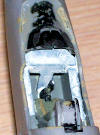 Along with other kits, this one was moved to Canada as well. Minor
damage was experienced but it still bugged me that the decals were not correct.
So down it went into a solution of bleach to remove the paint and decals. Looks
like I made a very good job in Argentina because it was a real struggle to
remove it properly. To a point that after one week there were many areas that
would not release. I bought a can of oven cleaner, and with patience, care and
an old toothbrush these rebel areas were cleaned in no time at all! Regretfully,
the carefully protected cockpit did not withstand the cleaner and the original
decals just bubbled away.
Along with other kits, this one was moved to Canada as well. Minor
damage was experienced but it still bugged me that the decals were not correct.
So down it went into a solution of bleach to remove the paint and decals. Looks
like I made a very good job in Argentina because it was a real struggle to
remove it properly. To a point that after one week there were many areas that
would not release. I bought a can of oven cleaner, and with patience, care and
an old toothbrush these rebel areas were cleaned in no time at all! Regretfully,
the carefully protected cockpit did not withstand the cleaner and the original
decals just bubbled away.
 The
plane looked quite good actually. I had done a decent job in Life #2. Only the
top of the right wing came off. Regretfully the fuselage got filled with bleach
that would not come out, so I was forced to drill to little holes in the fuel
tank located at the bottom of the fuselage in the tail area. After reattaching
the wing, I fixed the joints using putty, sandpaper and acrylic base (for the
wing root). The only problem is that the joint of the upper and lower halves of
the wing is close to some round panels/access doors under the wing, close to the
border of attack. This is an old kit so the panel lines are raised. After
sanding the putty I had to re-scribe these round doors. I also scratchbuilt the
supports to the air intakes and the two little wings on the tail.
The
plane looked quite good actually. I had done a decent job in Life #2. Only the
top of the right wing came off. Regretfully the fuselage got filled with bleach
that would not come out, so I was forced to drill to little holes in the fuel
tank located at the bottom of the fuselage in the tail area. After reattaching
the wing, I fixed the joints using putty, sandpaper and acrylic base (for the
wing root). The only problem is that the joint of the upper and lower halves of
the wing is close to some round panels/access doors under the wing, close to the
border of attack. This is an old kit so the panel lines are raised. After
sanding the putty I had to re-scribe these round doors. I also scratchbuilt the
supports to the air intakes and the two little wings on the tail.
Long
time ago I had copied some old Esci/Italieri decals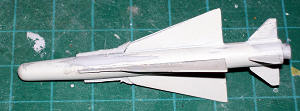 for Mirage in overheads
thinking to use them as stencils if needed. I still have these and the cockpit
ones were used. To do this, the area where these are located was given a hand of
white paint. The overheads were cut to fit and glued using little drops of
instant glue.
for Mirage in overheads
thinking to use them as stencils if needed. I still have these and the cockpit
ones were used. To do this, the area where these are located was given a hand of
white paint. The overheads were cut to fit and glued using little drops of
instant glue.
The
Matra 530, used in Life #1 and discarded in Life #2 was taken from the spares
box. One thing that I discovered is that though the shape is very good, a thin
extension of the
 fins was missing. Some thin plastic, glue, putty and sandpaper
fixed the missile.
fins was missing. Some thin plastic, glue, putty and sandpaper
fixed the missile.
Next challenge, the drop tanks. During these missions in May, the planes used the 1700 lt ones. After much thinking and playing with different ideas, I found that the ventral tanks for scooters are pretty similar in terms of diameter. With 4 available from as many Hobbycraft kits, I realized that with some surgery I could make 2 x 1700 lt tanks. The only other thing I had to do was add the fins and station, made with plasticard. I know they are not perfect (probably the fins could have been larger) but much better than using the 500 or 1300 lt tanks.
| COLORS & MARKINGS |
Paint:
White gloss (Acryl 4696) was used for the undersides and the missiles. Light
gray was used for several areas in the tail. After
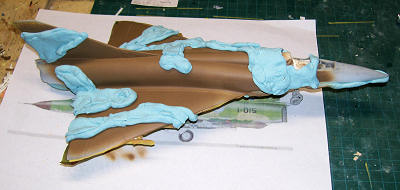 masking them with blue tac
(note that this Mirage had quite a high demarcation line in the nose area) I
applied the light brown (Acryl 4709). More masking and the two greens were applied (Acryl 4734and
4726). Then the nose was painted black, same as the details around the gray
areas in the tail. Aluminum was used for the wheel wells and internal side of
the landing gear doors. Moveable parts were highlighted with a sharpened pencil
and some black pastel applied here and there (not a lot).
masking them with blue tac
(note that this Mirage had quite a high demarcation line in the nose area) I
applied the light brown (Acryl 4709). More masking and the two greens were applied (Acryl 4734and
4726). Then the nose was painted black, same as the details around the gray
areas in the tail. Aluminum was used for the wheel wells and internal side of
the landing gear doors. Moveable parts were highlighted with a sharpened pencil
and some black pastel applied here and there (not a lot).
Three different shades of gray were used for the Matra 530.
Several hands of Future left the plane ready for the decals.
Decals:
The
set from Aerocalcas has all the stencils, roundels. I had to resort to modifying
a “9” to make it look a “5”. I had to add a little piece inside the round part
of the 5 to add a 45º angle instead of the 90º that would have shown had I not
added that little piece of black decal inside. The rounded top of the “6” was
replaced with a straight light taken from a “7”
All
decals went very well. The only one that is not in the current kit by Aerocalcas
is the one for the airbrakes and some yellow/black stripes over some access
lids/doors under the fuselage.
The
Matra 550 decal came from an Eduard Mirage that I have to build someday.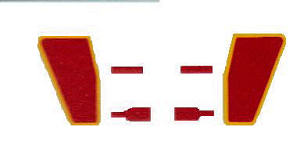
What I did with the brakes was to scan the brakes from another Mirage that I have and is waiting to be built. Then I erased the light blue background and printed them on clear decal paper. They worked great for the bottom airbrakes (white background). For the top ones, I cut the same shape/contour in white decal, I applied this one first to the brakes and then, on top of this, I added the red/yellow decal printed on the clear paper. Perfecto!
And
the yellow black stripes were from that overhead print with stencils that I
mentioned before. They were glued in place with some drops of Future.
I
had forgotten to paint the gray square behind the cockpit so as I realized about
this so late in the process, the solution was to cut it out from the white decal
paper. Great solution!
I added a strip of thin masking tape in the rear part of the black nose cone. The full plane was given a coat of semi gloss paint and when the masking tape was removed, there now was a “ring” of higher gloss as per pictures I have seen.
| FINAL CONSTRUCTION |
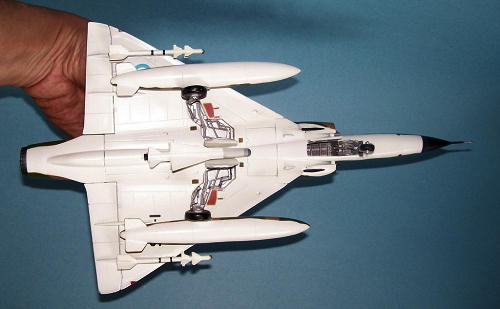 This
is the sequence to add the last parts:
This
is the sequence to add the last parts:
·
Nose landing gear lights (painted in chrome
silver)
·
Exhaust painted with a mix of silver and black
·
Wheels (chrome silver for some parts of the
landing gear)
·
Matra 550
·
Wheel wells doors
·
External tanks
·
Magic I/Matra 530
·
Gun sight from an old Mirage kit I found in the
spares box (lucky!)
·
Scratch built top ejection handle
·
Rear mirrors on the hood
·
Nose probe painted in silver
·
Formation lights on top and wing tips
·
Windshield
·
Two pitot tubes in front of windshield (the are
too long for the MIIIEA but I just kept them) and
· Finito!
| CONCLUSIONS |
I am
not completely satisfied with my kit because there are 4 things I found that are
not correct after I finished it:
1.
The green camo on the top right wing is too
thin,
2.
The serial number on the right fuselage should
sit on brown paint only and not over brown

3.
The Aerocalcas red ejection seat decals are a
little bit oversized so they are not centered with the air intake and
4.
A picture that Allan sent me shows that the
left side serial number close to the tail sits on only green paint. There was no
brown in that area as incorrectly shown in some profiles I’ve found in Internet.
But
this was the last time that I play with this kit. So there it is.
This
is my tribute to the unsung Mirage IIIEA pilots (compare to the fighter bomber
and other squadron pilots), especially to Garcia Cueva who lost his life trying
to save his plane.
With thanks to:
Ernesto Crespo
Allan White (information about the
crashed Mirages on May 1st and picture of Garcia Cuerva’s name in the
cenotaph at Darwin)
Juan Contreras (for his help to print
decals on decal paper, something I had never done before)
David Smith
Jose Miguel Rodriguez
Fabian Vera
| REFERENCES |
Historia de la Fuerza Aérea Argentina –
tomo VI, Volume I and II (Malvinas)
Aeroespacio (Argentine Air Force
magazine) # 534 – Mar/Apr 2000
Dassault Mirage IIICJ & IIIEA – Jorge
Nunez Padin – 2008
Air War in the Falklands 1982 by
Christopher Chant, Osprey, 2001
Falklands Air War – Chris Hobson w Andrew
Noble, Midland, 2005
Guerra Aérea en las Malvinas – Benigno
Andrada, Emece, 1983
Sea Harrier over the Falklands – Sharky Ward, Leo Cooper, 1993
June 2010If you would like your product reviewed fairly and quickly, please contact the editor or see other details in the Note to Contributors.
Back to the Review Index Page 2024